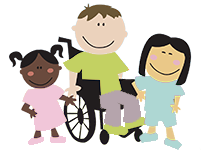Why is Bilateral Coordination Important for Your Child?
 You may have heard your occupational therapist state “We worked on bilateral coordination activities…” and wonder what does bilateral coordination mean and why is it so important? Bilateral coordination – also known as bilateral integration – is the ability to use both sides of the body at the same time. It is important because so many movements and actions require the use of both sides of our body in order to perform everyday tasks including walking, cutting, catching balls, and playing! When a child does not engage both sides or seems to favor one side exclusively then it is important to contact your pediatrician quickly!
You may have heard your occupational therapist state “We worked on bilateral coordination activities…” and wonder what does bilateral coordination mean and why is it so important? Bilateral coordination – also known as bilateral integration – is the ability to use both sides of the body at the same time. It is important because so many movements and actions require the use of both sides of our body in order to perform everyday tasks including walking, cutting, catching balls, and playing! When a child does not engage both sides or seems to favor one side exclusively then it is important to contact your pediatrician quickly!
Bilateral coordination can be broken down to symmetrical, reciprocal, and asymmetrical movements.
Symmetrical movements are when both hands and/or feet are performing the same motion. Examples include clapping, pull apart toys, and jumping. Both sides of the body are working together to perform the SAME motion.
Reciprocal movements include when the body differentiates both sides of the body using a rhythmical motion. This includes crawling, walking, riding a bike, and swimming.
Asymmetrical movements are very similar to reciprocal movements meaning both sides of the body are working together but both sides are performing separate tasks with one side leading and the other side supporting/assisting. This can be seen more so when performing activities using both your hands. For example, cutting paper, sewing, playing a musical instrument, and tying shoes are all great examples which demonstrate the importance of both hands working together -but each performing specialized sequences to complete the activity.
When performing bilateral activities, always start with symmetrical movements since they are easier and your child will have to master symmetrical skills before performing more complex and specialized activities. Children will develop these skills at different ages and rates so the most important reminder to remember is to have fun!
Fun Summer Activities:
Symmetrical –
- Zoom ball: Zoom ball requires both arms to work together to make the zoom ball move along the rope. You can have your child perform the task vertically and horizontally.
- Cleaning: use both hands with a large hand towel or sponge to wipe or scrub an area down. Car washes are a great way to get wet, have fun, and knock one task of your cleaning list!
- Popping large bubbles or bubble wrap: Ask the child to perform task simultaneously using both hands. Perform this to a song or with a timer to see who gets the most points.
Reciprocal & Asymmetrical-
- Snow Angel & jumping jacks – When at the beach, use the sand. Jumping jacks can be performed in front of a mirror to help with timing.
- Playdoh: have the child roll out the playdoh flat using a rolling pin and have them pound, squash, make balls and roll snakes or sausages using both hands.
- Crumbling paper: I prefer to use tissue paper but you can also use old magazine or newspaper and practice your two and three pointer line ups!
- Flying a kite: This requires both hands to steer or one hand feed the line and the other hand stabilize the roll.
- Musical instruments: anything that makes noise can be used as a musical instrument. Grab a couple of sticks and bang on a pot or put some beans into an empty water bottle to shake. Perform to a beat and create your own band!
More questions about Bilateral Coordination? Call us at Speech & Occupational Therapy of North Texas and a licensed occupational therapist will be happy to answer your questions. To learn more about motor development visit http://www.nlm.nih.gov/medlineplus/ency/article/001533.htm

Comments (0)